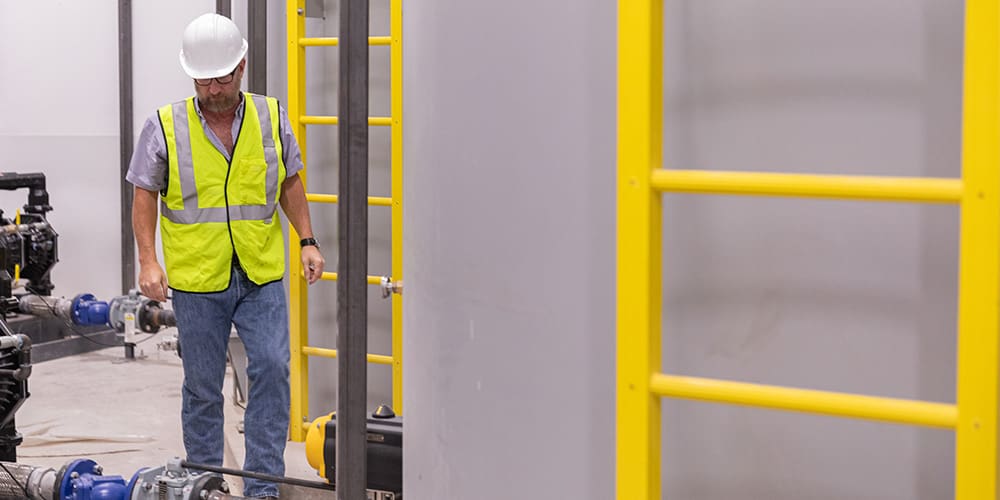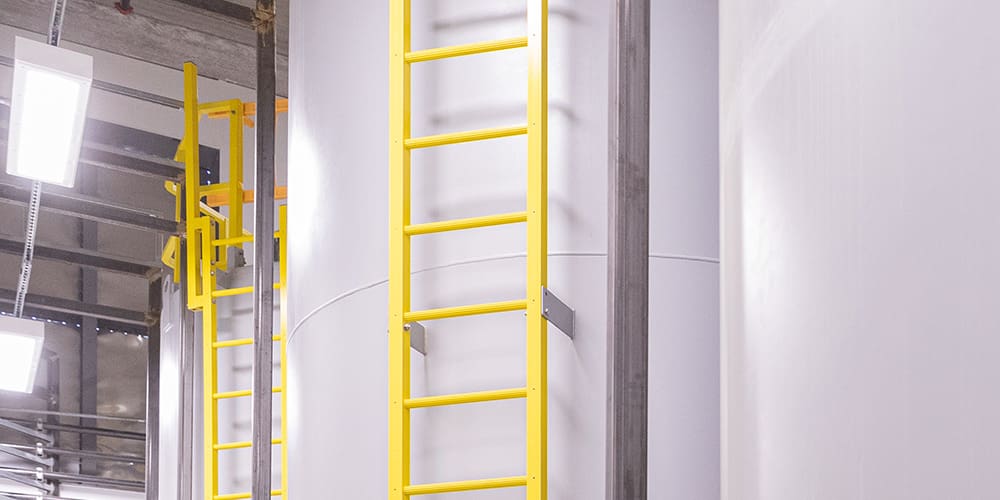As we observe the American Ladder Institute’s National Ladder Safety Month this March, it’s an opportunity for safety managers in industrial settings to reinforce their commitment to ladder safety. Ladders are indispensable tools in numerous industries, facilitating access to elevated work areas. However, without proper awareness, training and maintenance, they can pose significant risks to workers. In fact, during the National Safety Congress & Expo 2023, OSHA revealed a concerning statistic: Ladders ranked as the third most cited safety violation for FY 2023 in its annual top 10 list.

Understanding Safety Considerations
Understanding and implementing comprehensive safety considerations are paramount to ensuring the well-being of employees in industrial settings. From providing thorough training and awareness programs to emphasizing regular inspection and maintenance protocols and more, here are key strategies to promote ladder safety in the workplace:
- Training and awareness: Proper training is essential for all individuals who will be using fixed-access ladders. Educate users on safety guidelines, best practices and potential hazards. Encourage the adoption of safety measures such as climbing slowly and deliberately, maintaining three points of contact (facing the ladder and using both hands while climbing up and down) and wearing clean, slip-resistant footwear. Foster a culture of safety awareness where employees actively recognize and report ladder safety issues.
- Inspection and maintenance: Regular inspection and maintenance are imperative to ensure that ladders remain in optimal condition. Inspect the ladder thoroughly when purchased and before each use to ensure it’s in good working condition. If wear, damage or a potential hazard is identified, promptly contact the manufacturer for approved replacement parts and strictly adhere to provided instructions, avoiding any attempt to repair the ladder with unauthorized components or methods. Keep the ladder clean and follow manufacturer recommendations for cleaning to extend the ladder’s lifespan.
- Stabilization, setup and accessories: Properly anchoring and stabilizing fixed-access ladders is essential to mitigate the risk of accidents. Ensure that ladders are securely fastened and supported to prevent movement or instability during use. Additionally, meticulously install any accompanying accessories and components, such as safety gates, industrial platforms, catwalks and walkways to enhance overall safety and usability of the ladder system.
- Safe climbing and positioning: Emphasize the importance of safe climbing techniques, such as facing the ladder, avoiding overreaching or sudden movements and ensuring both hands remain free for climbing by utilizing a towline, tool belt or assistance to transport tools and equipment to the work area. Encourage users to maintain their balance and use caution when working at elevated heights.

OSHA Fixed-Ladder Requirements
When selecting industrial fixed-access ladders, it’s essential to ensure compliance with OSHA regulations. Bedford Reinforced Plastics’ ReadyLadder fixed-access industrial ladders adhere to OSHA 1910.23 specifications, as well as ANSI and IMC standards. ReadyLadder solutions are designed to meet the demands of diverse applications, including cooling towers, mining, oil & gas, plant & chemical processing, pulp & paper, utilities, wastewater & water treatment and many more.
If you have questions regarding whether a product meets specific codes, please reach out to Bedford for clarification and assistance. For details on the standard fixed ladder OSHA safety requirements, continue reading below. The exact subpart for fixed-ladders is OSHA 1910.23(d) – Fixed Ladders. The chart below focuses on subpart 1910.23(d) as it pertains to what employers must ensure and other codes that are important.
OSHA Fixed Ladder Requirements — 1910.23(d)
| OSHA Number | Definition |
|---|---|
| 1910.23(d) | Fixed ladders. The employer must ensure: |
| 1910.23(d)(1) | Fixed ladders are capable of supporting their maximum intended load; |
| 1910.23(d)(2) | The minimum perpendicular distance from the centerline of the steps or rungs, or grab bars, or both, to the nearest permanent object in back of the ladder is 7", except for elevator pit ladders, which have a minimum perpendicular distance of 4.5"; |
| 1910.23(d)(3) | Grab bars do not protrude on the climbing side beyond the rungs of the ladder that they serve; |
| 1910.23(d)(4) | The side rails of through or side-step ladders extend at least 42" above the top of the access level or landing platform served by the ladder. For parapet ladders, the access level is: |
| 1910.23(d)(4)(i) | The roof, if the parapet is cut to permit passage through the parapet; or |
| 1910.23(d)(4)(ii) | The top of the parapet, if the parapet is continuous; |
| 1910.23(d)(5) | For through ladders, the steps or rungs are omitted from the extensions, and the side rails are flared to provide not less than 24" and not more than 30" of clearance. When a ladder safety system is provided, the maximum clearance between side rails of the extension must not exceed 36"; |
| 1910.23(d)(6) | For side-step ladders, the side rails, rungs, and steps must be continuous in the extension; |
| 1910.23(d)(7) | Grab bars extend 42" above the access level or landing platforms served by the ladder; |
| 1910.23(d)(8) | The minimum size (cross-section) of grab bars is the same size as the rungs of the ladder. |
| 1910.23(d)(9) | When a fixed ladder terminates at a hatch, the hatch cover: |
| 1910.23(d)(9)(i) | Opens with sufficient clearance to provide easy access to or from the ladder; and |
| 1910.23(d)(9)(ii) | Opens at least 70 degrees from horizontal if the hatch is counterbalanced; |
| 1910.23(d)(10) | Individual-rung ladders are constructed to prevent the employee's feet from sliding off the ends of the rungs; |
| 1910.23(d)(11) | Fixed ladders having a pitch greater than 90 degrees from the horizontal are not used; |
| 1910.23(d)(12) | The step-across distance from the centerline of the rungs or steps is: |
| 1910.23(d)(12)(i) | For through ladders, not less than 7" and not more than 12" to the nearest edge of the structure, building, or equipment accessed from the ladders; |
| 1910.23(d)(12)(ii) | For side-step ladders, not less than 15" and not more than 20" to the access points of the platform edge; |
| 1910.23(d)(13) | Fixed ladders that do not have cages or wells have: |
| 1910.23(d)(13)(i) | A clear width of at least 15" on each side of the ladder centerline to the nearest permanent object; and |
| 1910.23(d)(13)(ii) | A minimum perpendicular distance of 30" from the centerline of the steps or rungs to the nearest object on the climbing side. When unavoidable obstructions are encountered, the minimum clearance at the obstruction may be reduced to 24", provided deflector plates are installed. |
Please note that according to section 1910.28, it is the employer’s responsibility to ensure the provision of fall protection for employees on fixed ladders. Additionally, section 1910.29 outlines the criteria for fall protection systems specifically designed for fixed ladders.
Other Important OSHA Ladder Codes
| OSHA Number | Definition |
|---|---|
| 1910.23(b)(4) | Fixed ladder rungs/steps have a minimum clear width of 16" |
| 1910.28(b)(9)(i) | For fixed ladders that extend more than 24' above a lower level, the employer must ensure: |
| 1910.28(b)(9)(i)(A) | Existing fixed ladders. Each fixed ladder installed before November 19, 2018, is equipped with a personal fall arrest system, ladder safety system, cage or well; |
| 1910.28(b)(9)(i)(B) | New fixed ladders. Each fixed ladder installed on and after November 19, 2018, is equipped with a personal fall arrest system or a ladder safety system; |
| 1910.28(b)(9)(i)(C) | Replacement. When a fixed ladder, cage or well, or any portion of a section thereof, is replaced, a personal fall arrest system or ladder safety system is installed in at least that section of the fixed ladder, cage or well where the replacement is located; and |
| 1910.28(b)(9)(i)(D) | Final deadline. On and after November 18, 2036, all fixed ladders are equipped with a personal fall arrest system or a ladder safety system. |
| 1917.118(e)(1) | Fixed ladders more than 20' in height must have a cage, well or ladder safety device. |
ReadyLadder: Enhancing Safety in Industrial Environments
At Bedford, we are committed to promoting safety and reducing ladder-related injuries through our fiberglass-reinforced plastic (FRP) ReadyLadder fixed-access ladder solutions. ReadyLadder is ideal for fixed-ladder applications from high roof access to short climbs — including water applications with recent NSF certification.
As part of our ReadySeries lineup, these FRP fixed-access ladders are designed to meet stringent safety standards while providing durability and reliability in industrial environments.

Advantages of ReadyLadder Solutions
ReadyLadder industrial fixed-access ladders offer unparalleled advantages from unmatched durability and ease of installation to compliance with safety standards and customizable options tailored to your needs.
- Quick shipping and easy installation: ReadyLadder FRP ladder components are prefabricated for easy assembly and installation, requiring only standard tools for installation. With stocked standard lengths and quick shipping, you can expedite the setup of your industrial ladder system without compromising on quality.
- Durability: Constructed from FRP, ReadyLadder components offer incredible strength and resilience. They are resistant to heat, corrosion, chemicals, saltwater and harsh weather conditions, ensuring longevity in challenging industrial environments.
- Compliance and safety: Our FRP ladders are equipped with nonslip rung surfaces and are available in OSHA-compliant safety yellow. The safety ladders are constructed with flame-retardant resins and UV inhibitors, further enhancing safety and compliance.
- Customization options: Whether you require a simple vertical ladder or a comprehensive ladder system with walk-throughs and fall protection, ReadyLadder offers versatile configuration options to suit your specific needs.
- Easy integration: Some ReadyLadder fixed-access ladder solutions seamlessly integrate with industrial platforms, catwalks and walkways, as well as other ReadySeries products, offering flexibility beyond conventional ladder systems.
Watch Now!
Watch the video below to see how ReadyLadder is designed to meet safety and productivity needs with speed and durability.
Learn More
To learn more about industrial plant safety, check out Industrial Plant Safety Questions Answered by an FRP Expert. If you’re curious about roof access ladders and OSHA roof access ladder requirements, read Roof Access Ladders Made Easy. Download a brochure to discover more about ReadyLadder solutions.
Ready to Take Safety to New Heights?
Prioritizing ladder safety in industrial settings is paramount to protecting the well-being of workers and mitigating workplace hazards. By investing in quality fixed-access ladder solutions like Bedford’s ReadyLadder, you can ensure compliance with safety regulations and promote a culture of safety awareness within your organization. Together, let’s step up to safety and make every climb a secure one.
Reach out with ladder safety questions, request a quote or call 814-623-8125 to discuss the needs of your project.